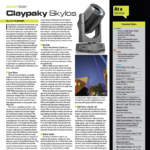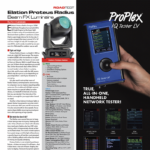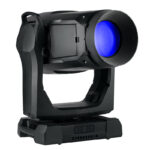With the popularity of LEDs on the rise and the increasing need for better tools to program them, the boundaries of existing software solutions is constantly being tested. Take, for instance, the world of pixel mapping. Once upon a time, pixel mapping more or less was confined to a 2D flat plane on which an image would be displayed. That has changed in the last several years. With products like Pixel Tubes (Eurolite) and LT 100/200 3D Graphic Tubes (SGM) being used to create three-dimensional structures of pixels, traditional 2D pixel mapping software quickly falls short of the task.
There is one solution, however, that is commonly found in almost every installation of pixels in a 3D space: Madrix. I first reviewed this “pixel mapping software, effects generator and playback controller for LED matrices” seven years ago (“Road Test,” PLSN, Aug. 2008) and decided to revisit this software to see what improvements and new features have been made and to learn about the process of programming in 3D.
What Is It?
First of all, for those not familiar with Madrix, the important thing to note is that Madrix is more than just a media server used to play back content. While it can do that easily, its strength and its uniqueness lies in its ability to create content via its internal effects generator in a way that’s very similar to the workflow of an image editing program.
The graphical user interface (GUI) used for programming looks is very straightforward, with A/B previews and main output scene and crossfade controls. Cueing up a scene in one of the preview areas is simple; just click on a scene and then press the crossfade button to make it live. There are a few options for the main output, like a global strobe function and crossfade time control, but otherwise, all of the timing of a scene is done during the programming of the scene itself.
How to Use It
The first step is to create the pixel map you will be displaying content on using the Patch Editor. You will also choose between DMX or DVI protocol for output in the Patch Editor. To add a fixture into your Pixel Map, simply click the ADD+ button on the top menu bar and you will be guided to a menu of Fixture profiles along with the necessary X, Y and Z coordinates where the fixture will be patched in the map. Once the map containing all of the fixtures and corresponding DMX values has been created, then you can exit the patch and you will then see the pixels in the playback.
The programming process begins by selecting an empty storage button in one of the storage areas under the A or B preview windows, then choosing an effect (non-audio effects are called SCE “Static Color Effect.”) Once an effect has been selected from the internal menu, then that effect can be manipulated using parameter controls in the effect controls area. The layer also has an Opacity control so to see the effect playing, make sure that is at value 255.

Scenes are stored in the A/B storage areas and are immediately ready for triggering. Scenes include all timing values for all parameters as well as the combination of layers required for the scene. One tricky thing to note is that as you are working on the scene, it is automatically updating into the storage (there is no STORE command needed), so I would recommend storing a copy of the scene before editing it if you plan to use it on several occasions in the show (such as a fast and slow version). A total of 256×256 scenes can be stored in the storage areas.
Playback of a scene is simple: select the storage button of the desired look and then click the FADE button under the MAIN OUTPUT window in the middle of the GUI. This allows a stored clip to be cued up and ready for the next transition in a very traditional A/B layout.
Another programming feature to point out is there are a lot of Sound2Lite and Music2Lite effects that can’t be used without an audio input, so I suggest making the effort to have an audio input when using Madrix in order to get the most out of the software.
From 2D to 3D
Madrix as a 2D effects generator is a lot of fun to work with, but you really get to see how much fun it is when you create a 3D pixel mapped object like a cube or sphere. Using the Patch Editor, creating an object is as simple as adding pixels to the Z coordinate (2D surfaces have a Z of “1”). Then you can decide which direction the image information will flow across the pixels (e.g., left to right, from top to bottom, across a diagonal, back to front) and combinations thereof. But Madrix’ Patch Editor helps make this process as straightforward as possible, and within a few minutes you are on your way to mapping video effects across the pixels of a 3D object.
For playback, Madrix can be triggered via DMX, MIDI and a variety of other I/O devices. It also has a Cue List function that can be triggered manually or via timecode, making it suited for use in a wide variety of applications, from clubs or live tours.
Some programming related features of note: Madrix also allows the user to create their own Macros containing scripts that can be used to modify and manipulate an effect, similar to a Quartz Composer type plug-in. These scripts are written by the user using programming language outlined in the user manual and are entirely customizable. These macros can then be applied to an effect, a scene, or even to the main output.
Touchscreen GUI
Something I inquired about while I was testing out Madrix is how much I would love for the software to be TouchOSC compatible so I could create my own user interface. While it does have a touchscreen GUI available (which would make it ideal for use with the Emulator from SmithsonMartin, in my opinion) that option is MIDI-based. If I could create my own interface — say, on my laptop — I think this software could probably have even more appeal for use in a wide range of applications, from conventions and tradeshow booths to possibly long-term installations such as in retail or transportation terminals.
Try Before You Buy
Madrix offers its software for a free demo from madrix.com. The trial version is fully functioning, but until it is purchased, the output gets shut off at random and then requiring a restart after an hour has elapsed. I installed it on my Windows 7 machine and had no issues whatsoever. The manual is easy to follow and has a great QuickStart section, and there are some great resources available online as well at http://help.madrix.com.
At a Glance
3D Pixel Mapping
Madrix’s LED lighting control solutions answer the need to extend pixel-mapping from 2D LED screens and lower-res panel fixtures to products like Pixel Tubes hanging in a 3D space.
Pros: The Madrix Patch Editor makes it easy (and fun) to map video effects across the pixels of a 3D object.
Cons: I would love for the software to be TouchOSC compatible to give me more options when it comes to creating my own user interface.
More Info: www.madrix.com
About Madrix
Madrix is a family of products including software that runs on a computer-desktop or laptop and hardware along with Plexus, Luna and Neo hardware devices.
Software: The latest software release, 3.4, will be available this month; the version Vickie Claiborne tested for this article was 3.3b. Many people run this PC native software on a Mac via Parallels or Boot Camp. Users can trigger the computer via numerous methods — MIDI, http, touch screen, analog DMX and Art-Net – which lets them trigger Madrix via lighting consoles.
Hardware: Plexus is a standalone media recorder/playback unit when users don’t need or want to have computers on site, such as with architectural installs. Luna 4, 8, or 16 units are Art-Net node or DMX512 USB interfaces designed to streamline data distribution. The Neo is a USB-to-DMX hardware element includes a one-universe Madrix license.
Pricing: Users purchase a license that is unlocked with a USB dongle (or installed in the Plexus and Neo hardware). Retail prices start at $375 for 1 universe to $6,000 for 256 universes of DMX and 1.3 million pixels. Users can upgrade to the next level (by email) as their lighting system grows; there is no penalty for not starting with the large license in the first place.



